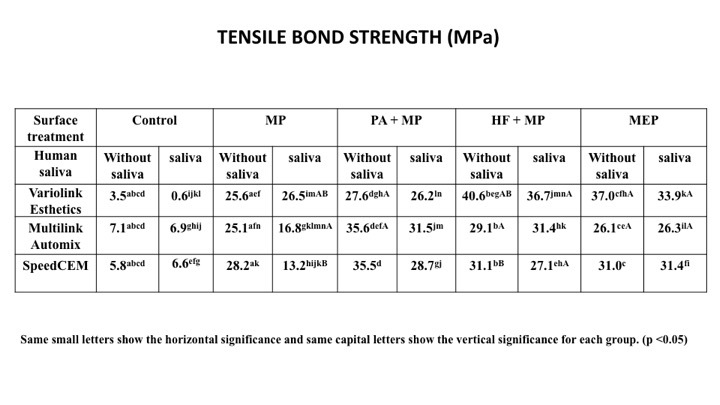IADR Abstract Archives
Efficacy of Various Surface Treatments on Saliva Contaminated Lithium-disilicate Ceramics
Objectives: The purpose of this study was to investigate the efficacy of different ceramic surface cleaning methods after saliva contamination on the resin bond strength to lithium disilicate ceramics.
Methods: A total of 300 blocks of e.max CAD (Ivoclar Vivadent) polished with 600-grit silicon carbide paper were prepared and divided into three groups (n=100) according to the resin cements employed; Variolink Esthetic DC (VE), Multilink Automix (MA) and SpeedCem (SC). The specimens were contaminated with or without human saliva. Each group was further divided into five subgroups (n=20) according to the surface treatment performed; without (Control), Monobond Plus (MP), 37% Phosphoric acid + Monobond Plus (PA + MP), 5% Hydrofluoric acid + Monobond Plus (HF + MP), and Monobond Etch & Prime (MEP). Chemical analysis of the ceramic surfaces of all groups was done by using X-ray photoelectron spectroscopy (XPS). For each group, 300 specimens were bonded. After 24 hrs water storage, tensile bond strength (TBS) was measured in a universal testing machine at a crosshead speed of 2 mm/min. The fractured surfaces were observed using scanning electron microscope (SEM). Results were statistically analyzed with 2-way ANOVA and t-test with Bonferroni correction.
Results: XPS analysis showed similar elemental distributions between with or without saliva in PA, HF and MEP. the TBSs were significantly influenced by surface treatments (ρ<0.05). HF + MP and MEP showed statistically similar bond strengths to saliva contamination of HF + MP and MEP but not in MP and saliva MP. The TBSs after 24 hrs was significantly higher in VE + HF+MP and VE + MEP. HF + MP and MEP did not show significant difference among any groups with or without saliva contamination.
Conclusions: Some of surface treatments (PA, HF, and MEP) were effective in removing saliva contamination and enhancing the resin bond strength. In the surface treatment of lithium disilicate glass-ceramics after saliva contamination, MEP demonstrated a possible substitution for the combination of 5% HF and MP.
Methods: A total of 300 blocks of e.max CAD (Ivoclar Vivadent) polished with 600-grit silicon carbide paper were prepared and divided into three groups (n=100) according to the resin cements employed; Variolink Esthetic DC (VE), Multilink Automix (MA) and SpeedCem (SC). The specimens were contaminated with or without human saliva. Each group was further divided into five subgroups (n=20) according to the surface treatment performed; without (Control), Monobond Plus (MP), 37% Phosphoric acid + Monobond Plus (PA + MP), 5% Hydrofluoric acid + Monobond Plus (HF + MP), and Monobond Etch & Prime (MEP). Chemical analysis of the ceramic surfaces of all groups was done by using X-ray photoelectron spectroscopy (XPS). For each group, 300 specimens were bonded. After 24 hrs water storage, tensile bond strength (TBS) was measured in a universal testing machine at a crosshead speed of 2 mm/min. The fractured surfaces were observed using scanning electron microscope (SEM). Results were statistically analyzed with 2-way ANOVA and t-test with Bonferroni correction.
Results: XPS analysis showed similar elemental distributions between with or without saliva in PA, HF and MEP. the TBSs were significantly influenced by surface treatments (ρ<0.05). HF + MP and MEP showed statistically similar bond strengths to saliva contamination of HF + MP and MEP but not in MP and saliva MP. The TBSs after 24 hrs was significantly higher in VE + HF+MP and VE + MEP. HF + MP and MEP did not show significant difference among any groups with or without saliva contamination.
Conclusions: Some of surface treatments (PA, HF, and MEP) were effective in removing saliva contamination and enhancing the resin bond strength. In the surface treatment of lithium disilicate glass-ceramics after saliva contamination, MEP demonstrated a possible substitution for the combination of 5% HF and MP.

